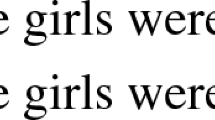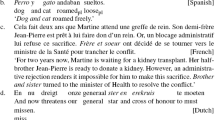Abstract
The semantic function of the modifier together in adnominal position has generally been considered to be that of preventing a distributive reading of the predicate. On the basis of a new range of data, I will argue that this view is mistaken. The semantic function of adnominal together rather is that of inducing a cumulative measurement of the group that together is associated with. The measurement-based analysis of adnominal together that I propose can also, with some modifications, be extended to adverbial occurrences of together.
Similar content being viewed by others
REFERENCES
Bayer, S.: 1993, 'Let's get “together”', manuscript, Brown University.
Beghelli, F. and T. Stowell: 1997, 'scope and Distributivity', in A. Szabolcsi (ed.), Ways of Scope Taking, pp. 72–154. Kluwer, Dordrecht.
Bennett, M.: 1974, Some Extensions of a Montague Fragment of English, PhD dissertation, UCLA.
Cresswell, M.: 1976, 'The Semantics of Degree', in B.H. Partee (ed.), Montague Grammar, pp. 261–292. Academic Press, New York.
Hoeksema, J.: 1983, 'Plurality and Conjunction', in A. ter Meulen (ed.), Studies in Modeltheoretic Semantics (GRASS 1), pp. 63–83. Foris, Dordrecht.
Kamp, H.: 1975, 'Two Theories of Adjectives', in E. L. Keenan (ed.), Formal Semantics of Natural Language, pp. 123–155. Cambridge University Press, Cambridge.
Keenan, E.: 1979, 'On Surface and Logical Form', in B. Kachru (ed.), Linguistics in the Seventies: Directions and Prospects, pp. 163–204. Dept. of Linguistics, University of Illinois, Urbana.
Klein, E.: 1980, 'A Semantics for Positive and Comparative Adjectives', Linguistics and Philosophy 4, 1–45.
Krantz, D., R. Luce, P. Suppes, and A. Tversky: 1971, Foundations of Measurement Theory, Volume 1, Academic Press, New York.
Krifka, M.: 1990, 'Four Thousand Ships Passed through the Lock', Linguistics and Philosophy 13, 487–520.
Krifka, M. et al. 1995, 'Genericity. An Introduction', in G.N. Carlson and F.J. Pelletier (eds.), The Generic Book, pp. 1–125. The University of Chicago Press, Chicago.
Lasersohn, P.: 1989, 'On the Readings of Plural Noun Phrases', Linguistic Inquiry 20, 130–134.
Lasersohn, P.: 1990, 'Group Action and Spatio-Temporal Proximity', Linguistics and Philosophy 13, 179–206.
Lerner, J.-Y. and M. Pinkal: 1992, 'Comparatives and Nested Quantification', in P. Dekker and M. Stokhof (eds.), Proceedings of the Eighth Amsterdam Colloquium, pp. 329–345. ILLC, University of Amsterdam, Amsterdam.
Link, G.: 1983, 'The Logical Analysis of Plurals and Mass Nouns', in R. Bäuerle, U. Egli, and A. von Stechow (eds.), Semantics from Different Points of View, pp. 303–323. De Gruyter, Berlin.
Moltmann, F.: 1992, Coordination and Comparatives, PhD dissertation, MIT.
Moltmann, F.: 1997a, Parts and Wholes in Semantics. Oxford University Press, New York.
Moltmann, F.: 1997b, 'Part-Structure Modifiers', in M. Simons and T. Galloway (eds.), Proceedings of SALT 5, Cornell University Press, Ithaca, N.Y.
Moltmann, F.: 1998, 'Part Structures, Integrity and the Mass-Count Distinction', Synthese 116, 75–111.
Rizzi, L.: 1990, Relativized Minimality, MIT Press, Cambridge, MA.
Roberts, C.: 1987, Modal Subordination, Anaphora; and Distributivity. PhD dissertation, University of Massachusetts, Amherst.
Scha, R.: 1991, 'Distributive, Collective, and Cumulative Quantification', in J. Groenendijk, et al. (eds.), Formal Methods in the Study of Language, pp. 131–158. Mathematical Centre, Amsterdam.
Schwarzschild, R.: 1992, 'Together as a Non-distributive Marker', in P. Dekker and M. Stokhof (eds.), Proceedings of the 8th Amsterdam Colloquium. ILLC, University of Amsterdam, Amsterdam.
Schwarzschild, R.: 1994, 'Plurals, Presuppositions, and the Sources of Distributivity', Natural Language Semantics 2, 201–248.
Sportiche, D.: 1988, 'A Theory of Floating Quantifiers and Its Corollaries for Constituent Structure', Linguistic Inquiry 19, 425–449.
Suppes, P. and J. Zinnes: 1963, 'Basic Measurement Theory', in R. D. Luce, R. Buch and E. Galanter (ed.), Handbook of Mathematical Psychology, Volume 1, pp. 1–76. Wiley & Sons, New York.
Szabolcsi, A.: 1997, 'strategies of Scope-Taking', in A. Szabolcsi, (ed.), Ways of Scope-Taking, pp. l09–154. Kluwer, Dordrecht.
Author information
Authors and Affiliations
Rights and permissions
About this article
Cite this article
Moltmann, F. The Semantics of Together . Natural Language Semantics 12, 289–318 (2004). https://doi.org/10.1007/s11050-004-6453-6
Issue Date:
DOI: https://doi.org/10.1007/s11050-004-6453-6




